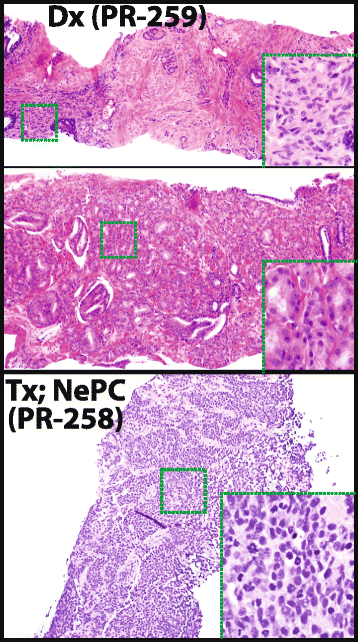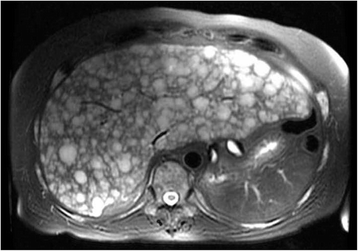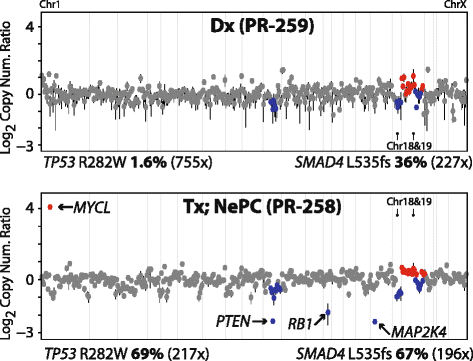Comprehensive serial molecular profiling of an "N of 1" exceptional non-responder with metastatic prostate cancer progressing to small cell carcinoma on treatment
- PMID: 26444865
- PMCID: PMC4596504
- DOI: 10.1186/s13045-015-0204-7
Comprehensive serial molecular profiling of an "N of 1" exceptional non-responder with metastatic prostate cancer progressing to small cell carcinoma on treatment
Abstract
Importance: Small cell carcinoma/neuroendocrine prostate cancer (NePC) is a lethal, poorly understood prostate cancer (PCa) subtype. Controversy exists about the origin of NePC in this setting.
Objective: To molecularly profile archived biopsy specimens from a case of early-onset PCa that rapidly progressed to NePC to identify drivers of the aggressive course and mechanisms of NePC origin and progression.
Design, setting, and participants: A 47-year-old patient presented with metastatic prostatic adenocarcinoma (Gleason score 9). After a 6-month response to androgen deprivation therapy, the patient developed jaundice and liver biopsy revealed exclusively NePC. Targeted next generation sequencing (NGS) from formalin-fixed paraffin-embedded (FFPE)-isolated DNA was performed from the diagnostic prostate biopsy and the liver biopsy at progression.
Intervention: Androgen deprivation therapy for adenocarcinoma followed by multiagent chemotherapy for NePC.
Main outcomes and measures: Identification of the mutational landscape in primary adenocarcinoma and NePC liver metastasis. Whether the NePC arose independently or was derived from the primary adenocarcinoma was considered based on mutational profiles.
Results: A deleterious somatic SMAD4 L535fs variant was present in both prostate and liver specimens; however, a TP53 R282W mutation was exclusively enriched in the liver specimen. Copy number analysis identified concordant, low-level alterations in both specimens, with focal MYCL amplification and homozygous PTEN, RB1, and MAP2K4 losses identified exclusively in the NePC specimen. Integration with published genomic profiles identified MYCL as a recurrently amplified in NePC.
Conclusions and relevance: NGS of routine biopsy samples from an exceptional non-responder identified SMAD4 as a driver of the aggressive course and supports derivation of NePC from primary adenocarcinoma (transdifferentiation).
Figures



Similar articles
-
Biallelic tumour suppressor loss and DNA repair defects in de novo small-cell prostate carcinoma.J Pathol. 2018 Oct;246(2):244-253. doi: 10.1002/path.5137. Epub 2018 Aug 28. J Pathol. 2018. PMID: 30015382
-
The long noncoding RNA landscape of neuroendocrine prostate cancer and its clinical implications.Gigascience. 2018 Jun 1;7(6):giy050. doi: 10.1093/gigascience/giy050. Gigascience. 2018. PMID: 29757368 Free PMC article.
-
Gene expression signatures of neuroendocrine prostate cancer and primary small cell prostatic carcinoma.BMC Cancer. 2017 Nov 13;17(1):759. doi: 10.1186/s12885-017-3729-z. BMC Cancer. 2017. PMID: 29132337 Free PMC article.
-
Molecular events in neuroendocrine prostate cancer development.Nat Rev Urol. 2021 Oct;18(10):581-596. doi: 10.1038/s41585-021-00490-0. Epub 2021 Jul 21. Nat Rev Urol. 2021. PMID: 34290447 Free PMC article. Review.
-
Molecular model for neuroendocrine prostate cancer progression.BJU Int. 2018 Oct;122(4):560-570. doi: 10.1111/bju.14207. Epub 2018 Apr 24. BJU Int. 2018. PMID: 29569310 Review.
Cited by
-
Neuroendocrine Tumors of the Prostate: Emerging Insights from Molecular Data and Updates to the 2016 World Health Organization Classification.Endocr Pathol. 2016 Jun;27(2):123-35. doi: 10.1007/s12022-016-9421-z. Endocr Pathol. 2016. PMID: 26885643 Review.
-
Tubulocystic Carcinoma of the Kidney With Poorly Differentiated Foci: A Frequent Morphologic Pattern of Fumarate Hydratase-deficient Renal Cell Carcinoma.Am J Surg Pathol. 2016 Nov;40(11):1457-1472. doi: 10.1097/PAS.0000000000000719. Am J Surg Pathol. 2016. PMID: 27635946 Free PMC article.
-
Targeted next-generation sequencing of CIC-DUX4 soft tissue sarcomas demonstrates low mutational burden and recurrent chromosome 1p loss.Hum Pathol. 2016 Dec;58:161-170. doi: 10.1016/j.humpath.2016.09.004. Epub 2016 Sep 21. Hum Pathol. 2016. PMID: 27664537 Free PMC article.
-
A gastric MANEC with an adenocarcinoma of fundic-gland type as exocrine component.Virchows Arch. 2017 Nov;471(5):673-678. doi: 10.1007/s00428-017-2178-z. Epub 2017 Jun 26. Virchows Arch. 2017. PMID: 28653202 No abstract available.
-
Imaging of Neuroendocrine Prostatic Carcinoma.Cancers (Basel). 2021 Nov 17;13(22):5765. doi: 10.3390/cancers13225765. Cancers (Basel). 2021. PMID: 34830919 Free PMC article. Review.
References
-
- Al-Ahmadie H, Iyer G, Hohl M, Asthana S, Inagaki A, Schultz N, et al. Synthetic lethality in ATM-deficient RAD50-mutant tumors underlies outlier response to cancer therapy. Cancer Discov. 2014;4(9):1014–1021. doi: 10.1158/2159-8290.CD-14-0380. - DOI - PMC - PubMed
Publication types
MeSH terms
Substances
Grants and funding
LinkOut - more resources
Full Text Sources
Other Literature Sources
Medical
Research Materials
Miscellaneous

